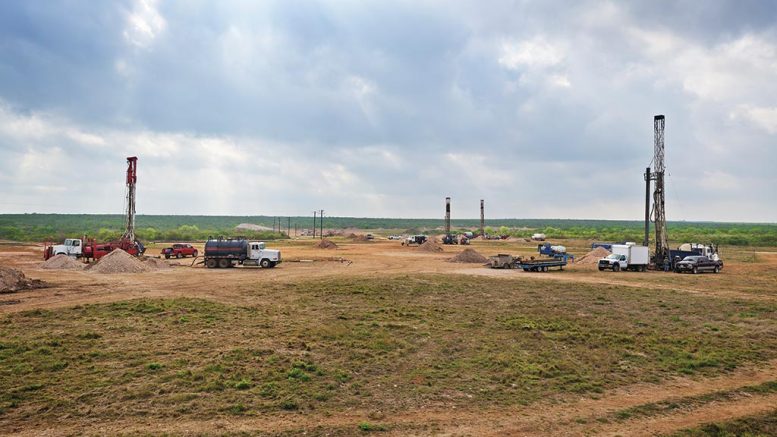As part of U.S. President Donald Trump’s proposed federal budget for fiscal 2021, his administration is requesting US$150 million annually over the next decade to stockpile U.S.-mined uranium in a new national Uranium Reserve.
The move is to help prop up domestic production as a matter of national energy security and re-establish the country’s nuclear fuel supply chain.
Trump’s “Budget for America’s Future” unveiled on Feb. 10, requests that the U.S. Congress approve a total of US$1.5 billion between 2021 and 2030 to set up the strategic Uranium Reserve.
“This is the very beginning of a long process to revitalize in many respects the entirety of the nuclear fuel cycle,” U.S. Energy Secretary Dan Brouillette told reporters on a teleconference. “What you’ve seen in the president’s budget is a request for US$150 million to begin the process of purchasing uranium.”
The idea for the Uranium Reserve evolved out of concerns from U.S.-based uranium mining interests about ways to bolster their industry. Last summer, uranium mining companies asked the Trump administration to impose quotas that would have forced uranium consumers in the U.S. to buy 25% of their uranium from domestic suppliers. However, the president declined the request and, instead, set up a task force to review the country’s nuclear fuel supply chain. Made up of national security, military and other federal officials, the Nuclear Fuel Working Group (NFWG) spent four months examining the supply chain and hearing from groups within the uranium mining sector. In November, the NFWG presented its report, which included the proposal for a national uranium reserve.
In addition to the Uranium Reserve, the budget for fiscal 2021, which runs from October 2020 until Sept. 2021, includes US$1.2 billion for research and development related to nuclear energy, a 43% increase over the US$824 million allocated for R&D in the current fiscal year.
The United States has the largest nuclear electricity generation capacity and generates more nuclear electricity than any other country in the world. According to the U.S. Energy Information Administration (EIA), the nuclear sector accounts for about 20% of the U.S.’s total electrical power generation, with 96 nuclear reactors operating in 58 commercial power plants across the U.S.

An American flag atop a drill rig at Azarga Uranium’s flagship Dewey Burdock uranium project in South Dakota. Credit: Azarga Uranium.
Those power plants consume about 48 million pounds of uranium annually. However, the vast majority of that supply comes from foreign sources. The EIA says that domestic uranium production in the United States has declined by some 96% in the last five years. The EIA’s most recent statistics show that American uranium miners accounted for just 10% of the supply needed by the U.S. nuclear energy industry, with domestic sources producing less than 174,000 pounds in 2019. By comparison, American uranium mine output stood at 4.9 million pounds in 2014. Currently, most of the commercial uranium used by the U.S. comes from primarily Canada (24%), Kazakhstan (20%), Australia (18%) and Russia (13%).
The spot price for uranium hovers just under US$25 per lb, and global demand for it has languished since the 2011 disaster at Japan’s Fukushima Daiichi Nuclear Power Plant. As well, the nuclear energy sector in the United States faces marketplace competition from cheaper alternatives, including natural gas, renewable wind and solar power.
For struggling uranium producers in the U.S., the budget request for a strategic reserve is welcome news.
“We appreciate the Trump Administration’s recognition of the national security risk from U.S. over reliance on imported uranium for 99% of uranium supplied to the commercial nuclear reactor fleet,” Spencer Abraham, chairman of U.S.-based mining and exploration company Uranium Energy (NYSE AM: UEC), stated in a press release. “The establishment of a Uranium Reserve will allow domestic uranium companies to restart some operations and begin to rebuild domestic uranium mining capability.”
Blake Steele, president and CEO of Azarga Uranium (TSX: AZZ), said establishing a strategic reserve is a clear sign that Washington recognizes the importance of domestic uranium mining.
“The budget proposal from President Trump confirms the administration’s commitment to reviving the United States nuclear fuel cycle, of which uranium mining is a critical component,” he said in a statement, noting that the announcement bodes well for Azarga’s flagship Dewey Burdock asset, an advanced stage in-situ recovery uranium project in South Dakota.
The Uranium Reserve plan is just one small part of the Trump administration’s record US$4.8 trillion federal budget and there are no assurances that it will be passed in Congress.
But it has given hope to many in the uranium sector.
“We hope Congress will support the Administration’s proposal and funding request,” UEC’s Abraham said. “The sooner action is taken the sooner we can put people back to work in the uranium mining sector and begin reducing our overdependence on uranium imports from countries that are not always aligned with U.S. interests.”


Be the first to comment on "Trump administration seeks to boost US uranium mining sector"